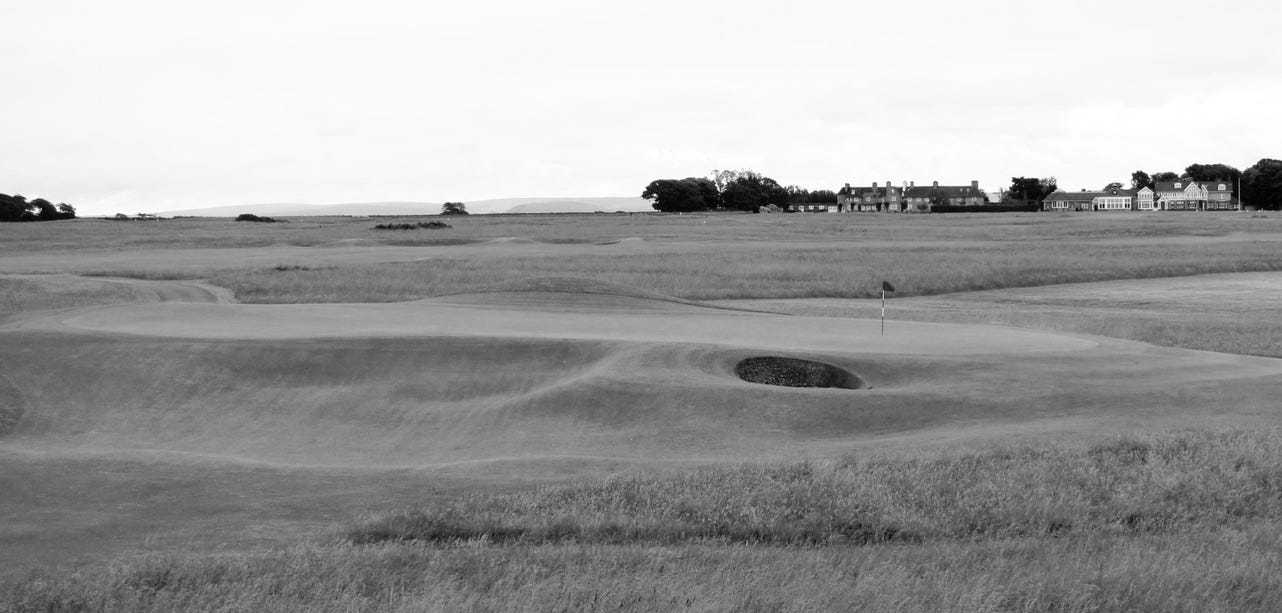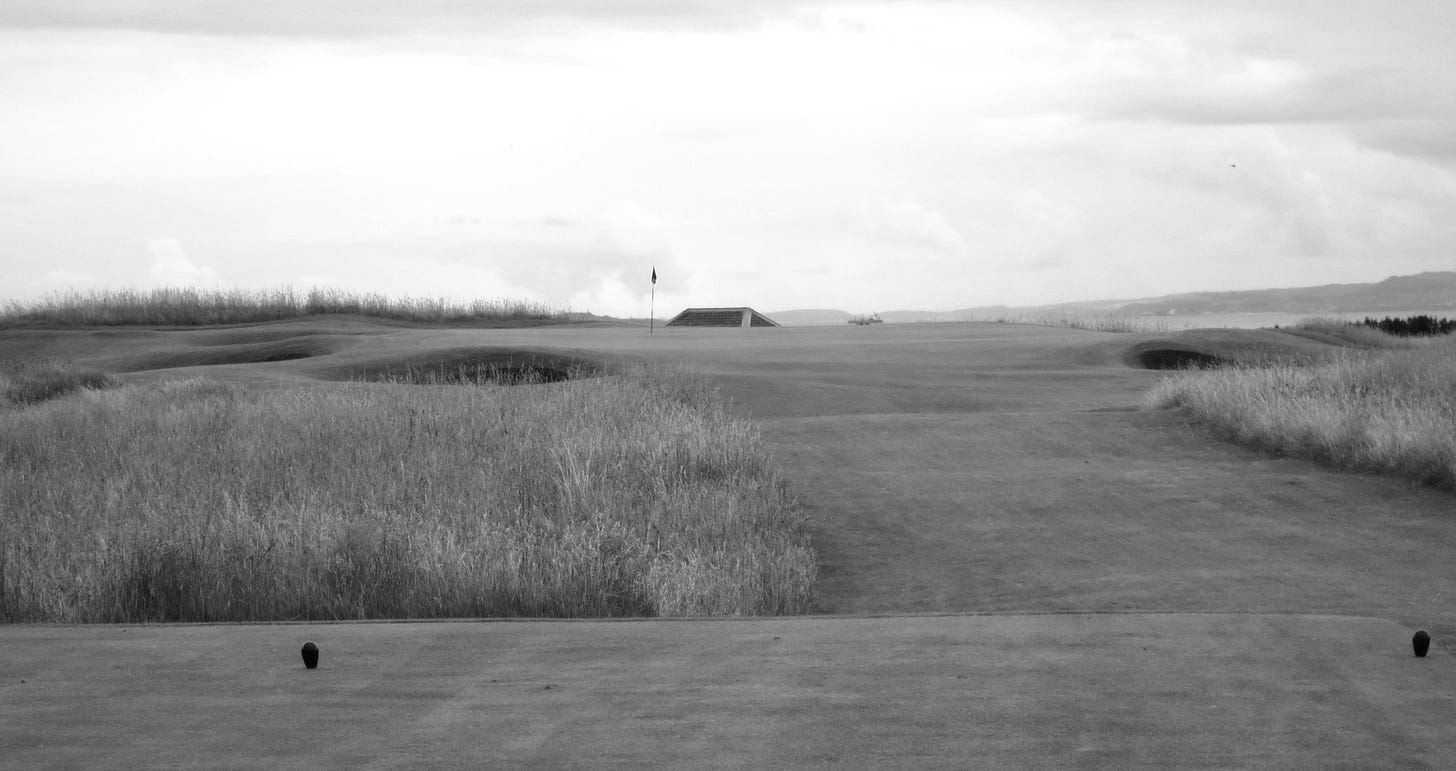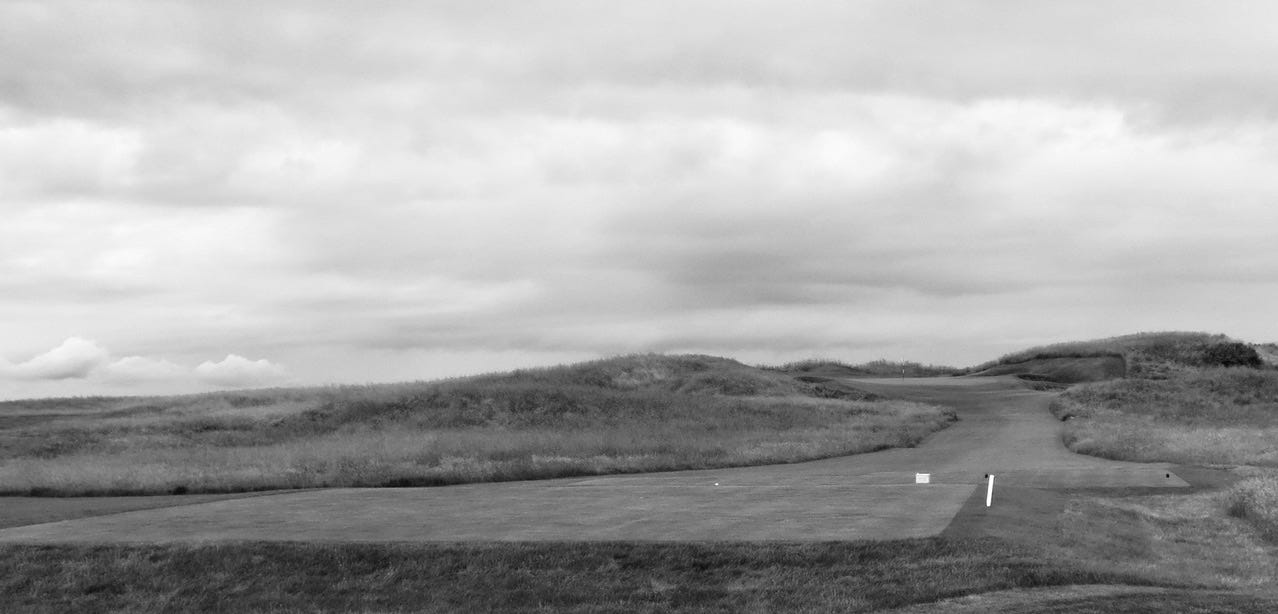Par-3’s That Go Up
Muirfield's set of par-3's provide an excuse to point out that most great one-shotters play uphill. Plus, an in-depth exploration of why they work and a listing of the best.
This week you’ll hear a lot about the kinder, friendlier and more progressive Honourable Company of Edinburgh golfers. But one thing has not changed since the club moved to a then-remote parcel of East Lothian links from their previous home at Musselburgh: they have an incredible set of 18 holes. And four fantastic par-3’s that will be pivotal in this week’s AIG Women’s Open Championship.
Whenever Muirfield hosts there is an inclination to focus on the 13th, a one-shotter that rises from the linksland and idyllically situated into a dune by architect Tom Simpson. Despite its difficulty and upward bound placement, this 160-yarder (in the Women’s Open) is universally revered.
The other par-3’s at Muirfield? They aren’t sexy at first glimpse. They play flat to uphill. With no water in play or dramatic carries over thrilling hazards, they are easily overlooked on a course full of sensational hole. But the par-3’s are nuanced and central to a course typically viewed by players as their rota favorite. (The women have already been making similar declarations, including a pre-tournament favorite, Brooke Henderson).
This is all a long-winded excuse to revisit the surprising and even taboo notion that the best par-3’s play flat or uphill.
“They’re some of the best par-3s, really,” says Adam Scott, who hales from a country where there is a ridiculous excess of world-class par-3’s in one neighborhood. All of Australia’s Sandbelt gems play a little uphill at places like Royal Melbourne, Kingston Heath and Victoria.
Architects prior to the late 20th Century real estate development era often used par-3’s to bridge awkward gaps in routings. Sometimes to disastrous effect. The most obvious may be Pebble Beach’s 5th, which was sandwiched inland when a stubborn landowner understandably valued overlooking Stillwater Bay.
That par-3 was eventually replaced in 1998 by a Jack Nicklaus-designed downhill one-shotter along the Pacific. But the new fifth’s seaside setting sold everyone on its replacement more than the chance to play downhill.
As late 20th Century course developers made the “signature” one-shotter a priority and any form of blindness was abhorrent, modern architects shied away from par-3’s where the green was even slightly elevated above the tee. Gone were stark one-shotters like Ballybunion Old’s all-or-nothing 12th or even a gentle-riser like the 16th at Augusta National. For some architects and developers, the slightest ascension to a green became pointless when you could just bulldoze things around to prop the tee up and the green below.
Other factors like playability, aesthetics and the immediate feedback you receive apparently justified moving mountains to make a par-3. (But sometimes any unenjoyable climb to get to such propped up tees.)
Geoff Ogilvy delineates between uphill par-3’s that work and those that offend.
“It’s nice to see a bit of the green surface,” said Ogilvy, who grew up playing Victoria where there are two fantastic uphillers. “It’s not as nice when you feel like you’re hitting it onto a roof.”
But the uphillers also make target focus much easier.
There is something simple about playing to a green sitting at or just above eye level. The golfer at address position can gently turn their head and make immediate visual contact with the target. Sometimes the “infinity” effect makes the flagstick stand out. None of this happens when a green is far below. Like the best stage views coming at eye level or even looking slightly up to the performers, the golfer can focus on a green set above them.
But from the balcony looking down? It’s easier to get distracted. Dimensions get flattened out. And it’s even questionable whether playing down is easier for most golfers.
“I almost feel like severe downhill ones are tougher because if there’s any wind your ball is up in the air so much longer and it’s tougher to judge the distance,” Scott says.
What about the fun factor? Jack Nicklaus believes down is (generally) better.
“I just think it’s a more pleasant game for people to see what you’re doing,” he says. “Does it mean you have to? No.”
With water having become a modern (and clichéd) staple of the ideal par-3, creating a lake or ascending creek means employing expensive and excessive earth work. Or worse, fake waterfalls. Even the architects known to force obstructed views or all-out blind shots into their work emphasized par-3 visibility and built some fine ones. But Pete Dye’s most famous one-shotters sit on flat ground.
“How much can you see better down or up?” Nicklaus asks. “Can you tell me where the pin is? Can you tell me what you’re looking at? I basically got that from Pete when I was working for him at Harbour Town. His philosophy was that golf is more pleasant game played downhill.”
For all its lay-of-the-land sensibilities, Muirfield evolved more than many of us realized. A recent book by Richard Latham does a fine job showing how H.S. Colt (first) and then Tom Simpson gave it four one-shotters that vary in feel and elevation from tee to green. Their flat-to-uphill nature fooled one of Muirfield’s most famous admirers into not noticing.
“It’d never entered my mind,” Nicklaus said when asked about Muirfield’s rising one-shotters. “When you go to a links golf course you play what’s there. For the most part Muirfield is pretty much in front of you.”
The fourth hole gets more difficult as you note the various ridges, shelves, drop-offs and other nuances seem. The hole initially feels downhill but that’s only because its tee is a bit artificially propped up and could use about a half hour of good bulldozer work to better meld into the land. The green also sits up in a way that looks inviting until you start noticing all that can go wrong. Including nearly-impossible recoveries from the left:
(A much lower back tee not in use this week extends the already-severe shot to a pain-inducing 226 yards and definitely plays uphill).
The next par-3 comes three holes later.
“The seventh is kind of an awkward little hole, the green sits up on a knob,” Nicklaus says of a par-3 created in advance of the 1935 Open Championship. Tom Simpson made multiple changes to Colt’s previous renovations and, as documented by Latham’s book, deserves great credit for shaping Muirfield into the course we see today. Simpson was uncharacteristically harsh in assessing Colt’s renovation, going so far to lament in all caps the “OBVIOUS & STRAIGHTFORWARD character” of six holes.
“There is a complete absence of subtlety at such holes as 1, 2, 4, 7, 10, 13 and 18,” he wrote in a report that is now displayed on the history-laden walls beneath renderings of each prior Honourable Company course. “In other words, there is at these holes no necessity for mental agility on the part of the player.”
He called the 7th “a terrible hole” and made a case for “a glorious site for a green 25 yards to the left of the present one.”
Then he unleashed.
“How anyone failed to notice this site, (made for a green) and greedily seize upon it, passes our comprehension.”
Simpson would eventually get approval to build today’s par-3 7th, playing 149 yards for the Women’s Open. And while it’s a fine hole discreetly receptive to a run-up shot, I’m not sure the green site screams “glorious.” But it’s a sneaky-tough shot that offers a great change of pace playing west.
Nick Faldo has a suggestion for approaching the 7th.
“It’s always a cross breeze with a 3-iron in your hand. It’s really more like a tough chip shot. I call them giant chip shots. You can’t just hit it up in the wind there because it could go anywhere.”
Simpson’s boldest effort came at the 13th, a Nicklaus favorite even though it plays uphills and is more attractive for a draw than his traditional left-to-right shot shape.
“What I like about 13 is that even though it is uphill, it’s basically a ridge and they just pushed some of the ridge back and then cut the green into that little section.”
Simpson’s disdain for Colt’s 13th was not as severe. But based on the need to create a Plasticine model for members to peruse in the clubhouse (oh where did that go?), the sales job was a bit tougher. Colt’s green sat in front of and slightly to the right of today’s 13th.
The old hole was referred to as the “Postage Stamp” and had its admirers, including Bernard Darwin, who sounded unsure about the Simpson changes when previewing the 1935 Open.
“The new green has been made rather higher up and to the left of the old green by by a process of cutting in to the side of the hill and largely altering the formulation of its slopes,” he wrote. “The present green is small and beset at its sides and backed by bunkers, and the perfect shot to it will have to be played with a slight hook. It will still make the ideal spot for watchers at championships, and they will enjoy themselves to the fullest if they want to see the eminent in difficulties.”
After getting member approval, Simpson insisted on his foreman overseeing the work. The resulting green, ideally nestled into the hill, remains a thrilling shot to play and a par-3 admired universally despite violating various tenets of fairness and (supposed) fun.
A whopping forty-one paces deep, the putting surface is guarded by three pot bunkers that have traditionally collected tee shots knocked down by the quartering wind out of the north. Another two pots guard the left and the green pitches back to front.
My favorite element of the 13th: the way it seems so inviting and yet, if the righthanded draw fails to turn over, finds this:






